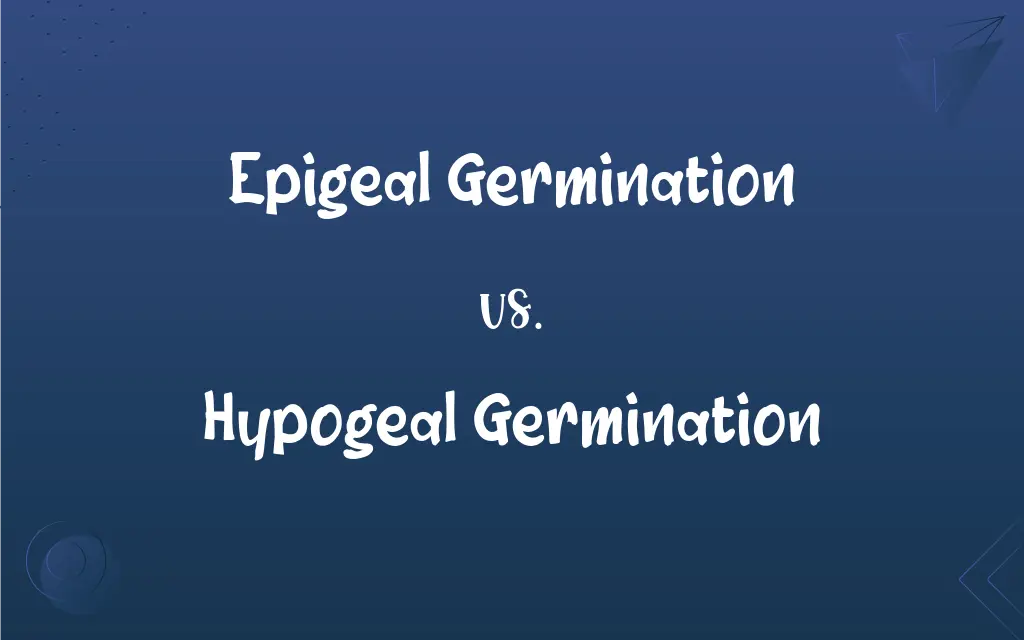Epigeal Germination vs. Hypogeal Germination: What's the Difference?
Edited by Aimie Carlson || By Harlon Moss || Updated on October 27, 2023
Epigeal germination involves cotyledons rising above the soil, while hypogeal germination keeps cotyledons underground.

Key Differences
In epigeal germination, the cotyledons, which are a plant's first set of leaves, are pushed above the soil due to elongation of the hypocotyl. In hypogeal germination, the cotyledons remain below the soil surface as the epicotyl elongates.
Epigeal germination is often seen in species where the cotyledons are fleshy and store food. On the other hand, in hypogeal germination, cotyledons are usually thin and do not emerge, serving as a food source while underground.
The advantage of epigeal germination is that the cotyledons, once above ground, can perform photosynthesis, providing additional energy. In contrast, plants with hypogeal germination rely on the food stored within the cotyledon until true leaves emerge and take over photosynthesis.
Examples of seeds that exhibit epigeal germination include beans and sunflowers. In contrast, peas and maize are examples of seeds that show hypogeal germination.
Both epigeal germination and hypogeal germination have evolved as adaptive strategies in plants, with each type offering distinct advantages depending on the plant's environment and life cycle requirements.
ADVERTISEMENT
Comparison Chart
Cotyledon Position
Cotyledons rise above the soil.
Cotyledons remain below the soil.
Elongation Part
Hypocotyl elongates.
Epicotyl elongates.
Function of Cotyledons
Perform photosynthesis when above ground.
Serve as a food source underground.
Common Examples
Beans, sunflowers.
Peas, maize.
Advantages
Cotyledons can photosynthesize, aiding early growth.
Protection from herbivory and environmental conditions.
ADVERTISEMENT
Epigeal Germination and Hypogeal Germination Definitions
Epigeal Germination
Epigeal germination involves the hypocotyl elongating to push the cotyledons upward.
Sunflowers are a classic representation of epigeal germination.
Hypogeal Germination
Hypogeal germination means cotyledons stay underground during seedling development.
Maize plants display hypogeal germination.
Epigeal Germination
Epigeal germination typically occurs in seeds with thick, fleshy cotyledons.
Most legumes showcase epigeal germination due to their thick cotyledons.
Hypogeal Germination
Hypogeal germination protects young cotyledons from herbivory.
Hypogeal germination offers an advantage in areas with many herbivores.
Epigeal Germination
Epigeal germination is when cotyledons emerge above the soil after germination.
Many garden beans exhibit epigeal germination.
Hypogeal Germination
Hypogeal germination relies on the epicotyl to grow and produce above-ground leaves.
In hypogeal germination, the first true leaves are seen above the soil.
Epigeal Germination
Epigeal germination provides advantages in environments requiring rapid initial growth.
With epigeal germination, plants can grow quickly in competitive habitats.
Hypogeal Germination
In hypogeal germination, cotyledons act as a nutrient source without surfacing.
Pea plants use their cotyledons as a food store during hypogeal germination.
Epigeal Germination
In epigeal germination, the cotyledons can photosynthesize post-emergence.
Epigeal germination allows young plants to harness sunlight early on.
Hypogeal Germination
Seeds with thin, non-photosynthetic cotyledons usually exhibit hypogeal germination.
Many grains, like rice, demonstrate hypogeal germination due to their thin cotyledons.
FAQs
Which part elongates in epigeal germination?
In epigeal germination, the hypocotyl elongates.
How does hypogeal germination differ?
In hypogeal germination, the cotyledons remain underground.
Can epigeal germination cotyledons photosynthesize?
Yes, in epigeal germination, the cotyledons can perform photosynthesis once above ground.
Which germination type is better for dry environments?
Hypogeal germination can be advantageous in dry environments due to underground protection.
Can gardeners influence a seed's germination type?
No, the type of germination is genetically determined and can't be changed by gardeners.
What is epigeal germination?
Epigeal germination is when the cotyledons rise above the soil after a seed germinates.
Is hypogeal germination more common in certain habitats?
Hypogeal germination is beneficial in areas prone to herbivory or where seedlings need protection.
Why do beans show epigeal germination?
Beans have fleshy cotyledons that rise above the ground, characteristic of epigeal germination.
Which part of the seedling elongates in hypogeal germination?
In hypogeal germination, the epicotyl elongates.
Do all seeds show either epigeal or hypogeal germination?
Most seeds exhibit one of the two, but variations and intermediate forms can exist.
Is the food storage different in epigeal vs. hypogeal germination?
Yes, epigeal cotyledons can photosynthesize, while hypogeal cotyledons primarily act as a food store.
Why don't hypogeal cotyledons photosynthesize?
Hypogeal cotyledons remain underground and hence can't access sunlight for photosynthesis.
How does herbivory impact hypogeal germination plants?
Hypogeal germination protects young cotyledons from being eaten, providing an advantage in high herbivory areas.
What's the primary advantage of hypogeal germination?
Hypogeal germination protects cotyledons from herbivores and harsh environmental conditions.
What determines if a seed will have epigeal or hypogeal germination?
Seed anatomy, environmental factors, and evolutionary benefits play roles in determining germination type.
Which germination type is more common?
Neither is universally more common; it depends on the plant species and environmental factors.
Can a plant switch between epigeal and hypogeal germination?
No, a plant's germination type is genetically determined and remains consistent for that species.
Which seeds typically show hypogeal germination?
Seeds like peas and maize typically exhibit hypogeal germination.
Can the type of germination impact a plant's lifespan?
While germination type can influence early growth stages, other factors play more significant roles in overall lifespan.
How do epigeal germination plants benefit in competitive environments?
Epigeal germination allows for rapid early growth and sunlight capture through cotyledon photosynthesis.
About Author
Written by
Harlon MossHarlon is a seasoned quality moderator and accomplished content writer for Difference Wiki. An alumnus of the prestigious University of California, he earned his degree in Computer Science. Leveraging his academic background, Harlon brings a meticulous and informed perspective to his work, ensuring content accuracy and excellence.
Edited by
Aimie CarlsonAimie Carlson, holding a master's degree in English literature, is a fervent English language enthusiast. She lends her writing talents to Difference Wiki, a prominent website that specializes in comparisons, offering readers insightful analyses that both captivate and inform.































































